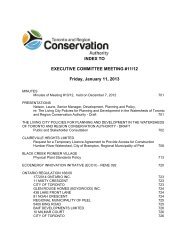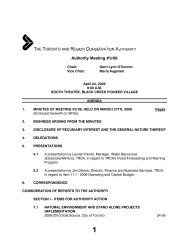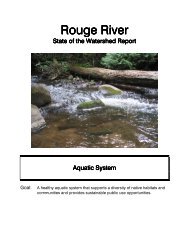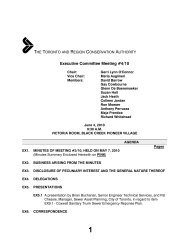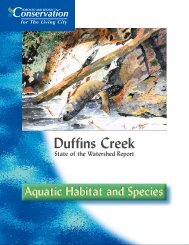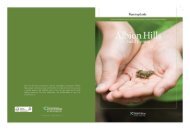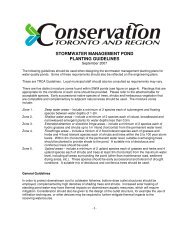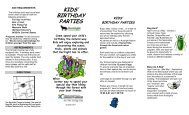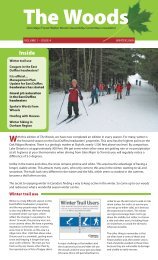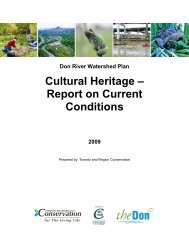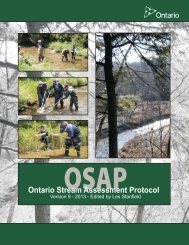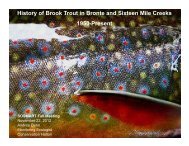Royal Rouge Trail Erosion Control Project - Toronto and Region ...
Royal Rouge Trail Erosion Control Project - Toronto and Region ...
Royal Rouge Trail Erosion Control Project - Toronto and Region ...
You also want an ePaper? Increase the reach of your titles
YUMPU automatically turns print PDFs into web optimized ePapers that Google loves.
neighboring Gyimah Sparks site (AkGs-044) (TRCA 2010b) <strong>and</strong> Jhuman site (AkGs-045)<br />
(TRCA 2010c) were dated predominantly to the Middle <strong>and</strong> Late Archaic, it was anticipated<br />
that this site would also prove to date to the Archaic as well. The third <strong>and</strong> final objective of<br />
the Stage 3 investigation was to determine the soil profile <strong>and</strong> the degree of disturbance at<br />
the site, particularly because the cluster identified during the Stage 2 assessment was<br />
located within three meters of an in-ground swimming pool. Additionally, Stage 2 testing<br />
across the entire project area indicated that soil depths varied <strong>and</strong> that there were pockets of<br />
disturbance with intermixture of 19 th <strong>and</strong> 20 th century materials. Stage 3 investigative units<br />
were h<strong>and</strong> excavated in 1m² units according to current technical st<strong>and</strong>ards on a five metre<br />
grid until units contained no artifacts, until areas of severe disturbance or obstacles were<br />
reached, or until a property with a registered site was reached that was to be assessed<br />
independently. Occasionally units were slightly relocated if stumps, rock gardens or other<br />
immovable objects were in the way. The TRCA restoration/erosion control staff responsible<br />
for the slope remediation advised that excavations within the drip line of trees on the<br />
properties be avoided <strong>and</strong> that any plantings that contribute to the stability of the adjacent<br />
slope be avoided. However, no large trees were encountered within the area excavated for<br />
this site. Units were excavated in stratigraphic layers to five centimeters below subsoil. Once<br />
the limits of the site were identified, additional units comprising at least 20% of the grid unit<br />
total were excavated in areas of dense artifact concentrations or where positive test pits were<br />
encountered during the Stage 2 assessment. Soil was screened through 6mm mesh to<br />
facilitate artifact recovery <strong>and</strong> all artifacts were collected <strong>and</strong> retained.<br />
Fourteen 1m² units were excavated during the Stage 3 investigation. Ten units were<br />
excavated on a five meter grid with an additional unit attempted but the area was thoroughly<br />
disturbed from pool <strong>and</strong> patio construction. An additional four units were excavated in areas<br />
of dense artifact concentration or in selected locations where positive Stage 2 test pits were<br />
encountered. No diagnostic Woodl<strong>and</strong> artifacts, such as body sherds, were encountered;<br />
instead all artifacts found were lithics. A total of 118 artifacts were collected from the 14 1m 2<br />
units. This included 117 flakes, <strong>and</strong> 1 projectile point fragment. The Stage 3 investigation<br />
suggested that the Corvese site is a Late Archaic campsite. Due to the threat of erosion <strong>and</strong><br />
the proposed erosion control measures to be implemented, it was determined that avoidance<br />
<strong>and</strong> protection was not a viable option for this sensitive resource <strong>and</strong> that Stage 4 excavation<br />
was required.<br />
The purpose of the Stage 4 excavation of the Corvese site was to document <strong>and</strong> remove the<br />
site data as completely as possible given the constraints of working in a subdivision with<br />
fences, decks, swimming pools, gardens <strong>and</strong> disturbed soils <strong>and</strong> also with the inherent risks<br />
of moving large quantities of soil in an area at risk of severe erosion. In accordance with<br />
Ministry technical st<strong>and</strong>ards, Stage 4 1m² units were excavated surrounding any Stage 3<br />
units that contained lithic artifacts numbering ten or more, or with diagnostic lithic artifacts. A<br />
total of 37 1m 2 units were excavated during the block excavation. The Stage 4 units were<br />
excavated in stratigraphic layers to five centimeters below subsoil. Wherever possible the<br />
excavation of 1m² units continued until there were yields or fewer than ten artifacts at the<br />
edge of the block excavation. Exceptions were limited to areas of disturbance alongside the<br />
swimming pool. Ordinarily test units would be excavated up to 10 metres beyond the block<br />
excavation, however in this instance the limits were constrained by a steep slope to the north,<br />
<strong>and</strong> a swimming pool <strong>and</strong> deck to the south. To the west, the Jhuman site (AkGs-045) was<br />
fully excavated under PIF P338-010-2010 (TRCA 2010b). In total, 602 artifacts were collected<br />
30<br />
<strong>Project</strong> Plan<br />
<strong>Toronto</strong> <strong>and</strong> <strong>Region</strong> Conservation Authority<br />
<strong>Royal</strong> <strong>Rouge</strong> <strong>Trail</strong> <strong>Erosion</strong> <strong>Control</strong> <strong>Project</strong> January 2010



